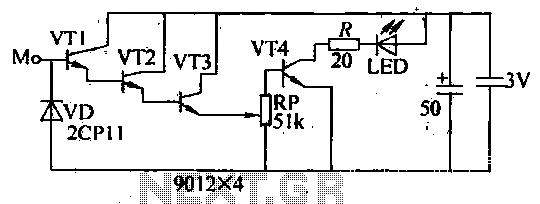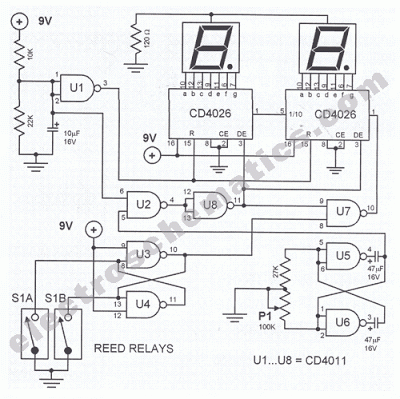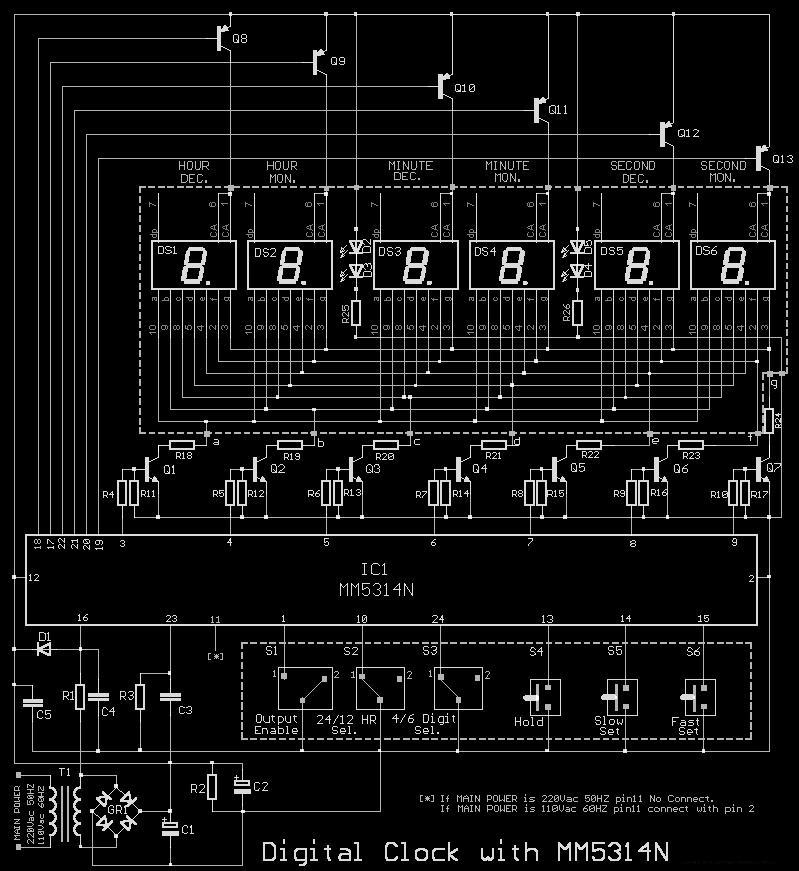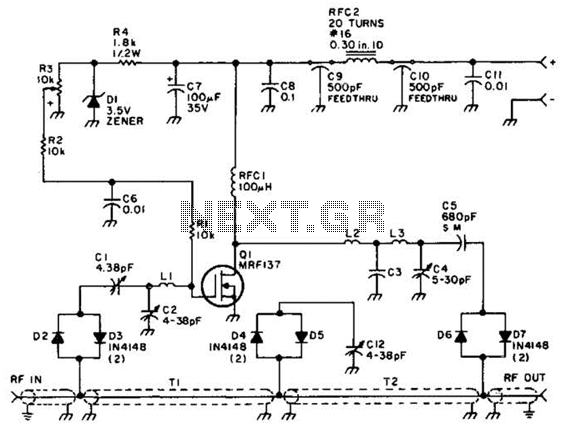
Wireless Car Alarm circuit diagram
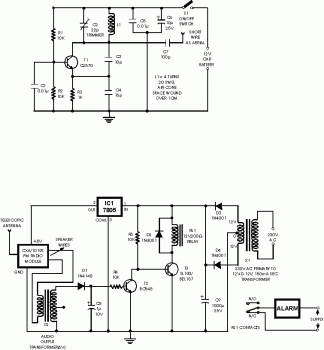
This circuit is a wireless car alarm system constructed using two modules: a transmitter module and a receiver module. It operates on FM radio waves and is suitable for vehicles with a power supply of 6-12VDC. A voltage stabilizer can be employed if the car's power supply exceeds this range (e.g., 24V). The mini VHF FM transmitter is installed in the vehicle when parked. The receiver unit utilizes the CXA1019, a single IC-based FM radio module that is readily available in the market. The receiver is tuned to the transmitter's frequency. When the transmitter is active and signals are received by the FM radio receiver, there is no hissing noise at the output. Consequently, transistor T2 (BC548) does not conduct, allowing the relay driver transistor T3 to receive its forward base bias through a 10k resistor (R5), thus energizing the relay. If an intruder attempts to drive the car away, the radio link between the transmitter in the car and the receiver is disrupted, resulting in the FM radio module generating a hissing noise. This hissing AC signal is coupled to the relay switching circuit via an audio transformer. The AC signals are then rectified and filtered by diode D1 and capacitor C8, producing a positive DC voltage that provides forward bias to transistor T2. As a result, transistor T2 conducts and pulls the base of relay driver transistor T3 to ground level, deactivating the relay and activating the alarm connected through the normally closed (N/C) contacts of the relay. If the intruder disconnects the transmitter from the battery, the alarm remains activated because the receiver continues to produce hissing noise in the absence of a signal, ensuring the burglar alarm is fool-proof and highly reliable.
The wireless car alarm system utilizes two primary modules: the transmitter and receiver. The transmitter, which operates on FM radio waves, is designed to be compact and is typically housed within the vehicle. It transmits signals to the receiver, which is strategically placed within the vicinity of the parked vehicle. The CXA1019 FM radio module serves as the heart of the receiver, providing reliable signal reception and processing.
The system is designed to function within a specific voltage range, making it compatible with most automotive power supplies. If a vehicle operates on a higher voltage, such as 24V, a voltage stabilizer is recommended to prevent damage to the circuit components.
When the vehicle is parked, the transmitter remains in a low-power state, continuously sending out a signal. The receiver, tuned to this frequency, remains silent as long as the signal is intact. The absence of noise at the receiver output indicates that the vehicle is secure. The circuit employs a transistor-based relay driver configuration, where the relay is energized when the receiver detects the transmitter's signal.
In the event of unauthorized movement of the vehicle, the disconnection of the transmitter’s signal triggers the FM radio module to generate a hissing sound. This sound is critical as it activates the alarm system. The audio transformer plays a crucial role in coupling the hissing AC signals to the relay circuit, which is then processed through the rectification and filtering stages involving diode D1 and capacitor C8. This ensures that the alarm system is activated promptly upon detection of an intruder.
The design emphasizes reliability and tamper-resistance, ensuring that even if an intruder attempts to disable the transmitter, the alarm remains active. The continuous generation of hissing noise in the absence of a signal acts as a fail-safe mechanism, providing an additional layer of security for the vehicle. Overall, the wireless car alarm system presents a robust solution for vehicle protection, leveraging simple yet effective electronic components to ensure a high level of security.This circuit is a wireless car alarm system that is built using two circuit modules, namely modules of transmitter and receiver modules. This circuit works on FM radio waves. Car alarms can be used on vehicles that have a 6-12VDC power supply. You can use the voltage stabilizer if your car power supply is too large (eg 24V). The mini VHF, FM trans mitter is fitted in the vehicle at night when the car is parked in the car porch. The receiver unit is built with CXA1019. CXA1019 a single IC-based FM radio module which is freely available in the market, is kept inside. Receiver is tuned to the transmitter`s frequency. When the transmitter is on and the signals are being received by FM radio receiver, no hissing noise is available at the output of receiver. Thus transistor T2 (BC548) does not conduct. This results in the relay driver transistor T3 getting its forward base bias via 10k resistor R5 and the relay gets energised.
When an intruder tries to drive the car and takes it a few metres away from the car porch, the radio link between the car (transmitter) and alarm (receiver) is broken. As a result FM radio module will generate hissing noise. Hissing AC signals are coupled to relay switching circuit via audio transformer. These AC signals are rectified and filtered by diode D1 and capacitor C8, and the resulting positive DC voltage provides a forward bias to transistor T2.
Thus transistor T2 conducts, and it pulls the base of relay driver transistor T3 to ground level. The relay thus gets de-activated and the alarm connected via N/C contacts of relay is switched on. If the intruder finds out about the wireless alarm (which already turned on) and disconnects the transmitter from battery, still remote alarm remains activated. It will not turn off the alarm because in the absence of signal, the receiver continues to produce hissing noise at its output.
So the burglar alarm is fool-proof and highly reliable. 🔗 External reference
The wireless car alarm system utilizes two primary modules: the transmitter and receiver. The transmitter, which operates on FM radio waves, is designed to be compact and is typically housed within the vehicle. It transmits signals to the receiver, which is strategically placed within the vicinity of the parked vehicle. The CXA1019 FM radio module serves as the heart of the receiver, providing reliable signal reception and processing.
The system is designed to function within a specific voltage range, making it compatible with most automotive power supplies. If a vehicle operates on a higher voltage, such as 24V, a voltage stabilizer is recommended to prevent damage to the circuit components.
When the vehicle is parked, the transmitter remains in a low-power state, continuously sending out a signal. The receiver, tuned to this frequency, remains silent as long as the signal is intact. The absence of noise at the receiver output indicates that the vehicle is secure. The circuit employs a transistor-based relay driver configuration, where the relay is energized when the receiver detects the transmitter's signal.
In the event of unauthorized movement of the vehicle, the disconnection of the transmitter’s signal triggers the FM radio module to generate a hissing sound. This sound is critical as it activates the alarm system. The audio transformer plays a crucial role in coupling the hissing AC signals to the relay circuit, which is then processed through the rectification and filtering stages involving diode D1 and capacitor C8. This ensures that the alarm system is activated promptly upon detection of an intruder.
The design emphasizes reliability and tamper-resistance, ensuring that even if an intruder attempts to disable the transmitter, the alarm remains active. The continuous generation of hissing noise in the absence of a signal acts as a fail-safe mechanism, providing an additional layer of security for the vehicle. Overall, the wireless car alarm system presents a robust solution for vehicle protection, leveraging simple yet effective electronic components to ensure a high level of security.This circuit is a wireless car alarm system that is built using two circuit modules, namely modules of transmitter and receiver modules. This circuit works on FM radio waves. Car alarms can be used on vehicles that have a 6-12VDC power supply. You can use the voltage stabilizer if your car power supply is too large (eg 24V). The mini VHF, FM trans mitter is fitted in the vehicle at night when the car is parked in the car porch. The receiver unit is built with CXA1019. CXA1019 a single IC-based FM radio module which is freely available in the market, is kept inside. Receiver is tuned to the transmitter`s frequency. When the transmitter is on and the signals are being received by FM radio receiver, no hissing noise is available at the output of receiver. Thus transistor T2 (BC548) does not conduct. This results in the relay driver transistor T3 getting its forward base bias via 10k resistor R5 and the relay gets energised.
When an intruder tries to drive the car and takes it a few metres away from the car porch, the radio link between the car (transmitter) and alarm (receiver) is broken. As a result FM radio module will generate hissing noise. Hissing AC signals are coupled to relay switching circuit via audio transformer. These AC signals are rectified and filtered by diode D1 and capacitor C8, and the resulting positive DC voltage provides a forward bias to transistor T2.
Thus transistor T2 conducts, and it pulls the base of relay driver transistor T3 to ground level. The relay thus gets de-activated and the alarm connected via N/C contacts of relay is switched on. If the intruder finds out about the wireless alarm (which already turned on) and disconnects the transmitter from battery, still remote alarm remains activated. It will not turn off the alarm because in the absence of signal, the receiver continues to produce hissing noise at its output.
So the burglar alarm is fool-proof and highly reliable. 🔗 External reference
Warning: include(partials/cookie-banner.php): Failed to open stream: Permission denied in /var/www/html/nextgr/view-circuit.php on line 713
Warning: include(): Failed opening 'partials/cookie-banner.php' for inclusion (include_path='.:/usr/share/php') in /var/www/html/nextgr/view-circuit.php on line 713
